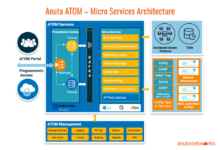Cloud Networking and SD-WAN: The Key to Modern Networking
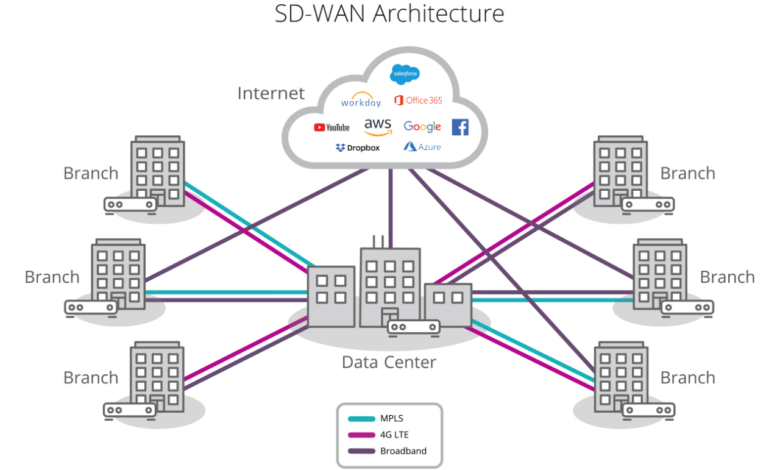
Cloud networking and SD-WAN solutions are revolutionizing the way businesses connect and communicate. With their ability to deliver secure, scalable, and cost-effective connectivity, these solutions are empowering organizations to meet the demands of the modern digital landscape. Dive into this comprehensive guide to discover the benefits, use cases, and best practices of cloud networking and SD-WAN, and unlock the potential for your business.
Definition of Cloud Networking and SD-WAN Solutions
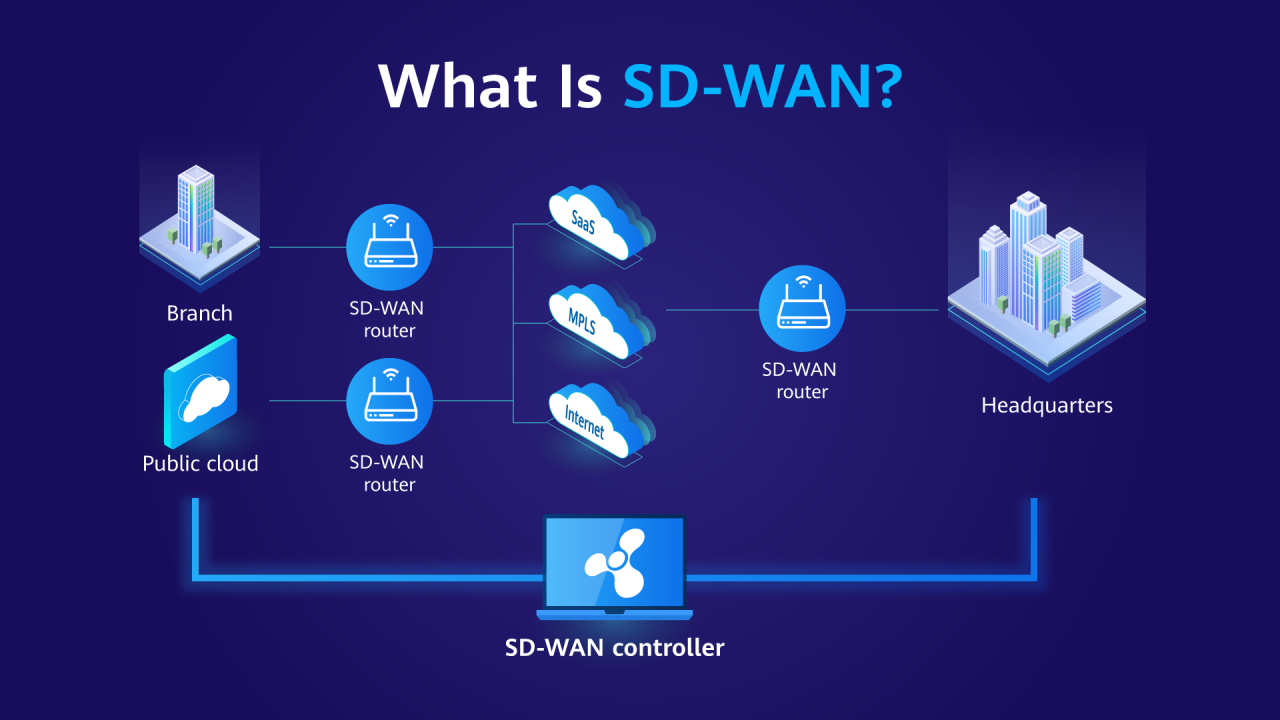
Cloud networking is a revolutionary approach to network management that leverages the scalability, flexibility, and cost-effectiveness of cloud computing. By migrating network infrastructure and services to the cloud, businesses can streamline their operations, reduce costs, and gain greater agility.
Key Components of a Cloud Network
- Virtual Private Cloud (VPC):A private, isolated section of the cloud network dedicated to a specific organization.
- Virtual Routers:Software-defined routers that connect different VPCs and provide routing functionality.
- Firewalls:Cloud-based firewalls that protect the network from unauthorized access and threats.
- Load Balancers:Distribute traffic across multiple servers to ensure high availability and performance.
SD-WAN: Definition and Benefits
Software-Defined Wide Area Network (SD-WAN) is a modern approach to WAN connectivity that leverages software-defined networking (SDN) principles. Unlike traditional WANs, which rely on proprietary hardware and complex configurations, SD-WANs are highly programmable and flexible, enabling businesses to adapt quickly to changing network requirements.
- Cost Savings:SD-WANs can significantly reduce WAN costs by leveraging low-cost broadband and Internet connectivity.
- Increased Agility:The software-defined nature of SD-WANs allows for rapid provisioning and reconfiguration of network resources.
- Improved Performance:SD-WANs optimize traffic routing based on application requirements, ensuring optimal performance for critical applications.
- Enhanced Security:Cloud-based security services and centralized management provide robust protection against cyber threats.
Benefits of Cloud Networking and SD-WAN Solutions
Cloud networking and SD-WAN solutions offer a plethora of benefits that can revolutionize your network infrastructure and empower your business to thrive in the digital age. Let’s delve into the advantages of these transformative technologies:
Scalability and Flexibility
Cloud networking provides unparalleled scalability, enabling you to seamlessly expand your network as your business grows. The elastic nature of the cloud allows you to allocate resources on demand, eliminating the need for costly hardware upgrades or complex configurations. Additionally, SD-WAN offers exceptional flexibility, allowing you to customize your network to meet the unique requirements of your applications and business operations.
Cost-Effectiveness
Cloud networking and SD-WAN can significantly reduce your IT expenses. By eliminating the need for physical infrastructure and costly hardware, cloud networking offers a pay-as-you-go model that scales with your usage. SD-WAN further enhances cost-effectiveness by optimizing bandwidth utilization, reducing the need for expensive leased lines, and enabling cost-effective connectivity across distributed locations.
Improved Performance
SD-WAN delivers exceptional performance improvements by intelligently routing traffic across multiple links. This ensures optimal bandwidth utilization and minimizes latency, resulting in a seamless and responsive user experience. Cloud networking complements SD-WAN by providing access to high-performance cloud-based services, such as content delivery networks (CDNs) and security solutions, further enhancing network performance.
Increased Agility
Cloud networking and SD-WAN empower your business with increased agility to adapt to changing business needs. The cloud-based nature of these solutions enables rapid provisioning of new services and applications, allowing you to quickly respond to market demands and seize new opportunities.
SD-WAN’s programmability further enhances agility by automating network configurations and enabling dynamic adjustments to meet evolving business requirements.
Case Studies
- A leading global financial institution implemented a cloud networking and SD-WAN solution to support its remote workforce. The solution enabled secure and reliable access to critical applications, resulting in increased employee productivity and improved customer service.
- A multinational manufacturing company deployed SD-WAN to optimize its global network infrastructure. The solution reduced bandwidth costs by 30% while improving application performance and enhancing operational efficiency.
– Identify the key factors to consider when implementing cloud networking and SD-WAN solutions.
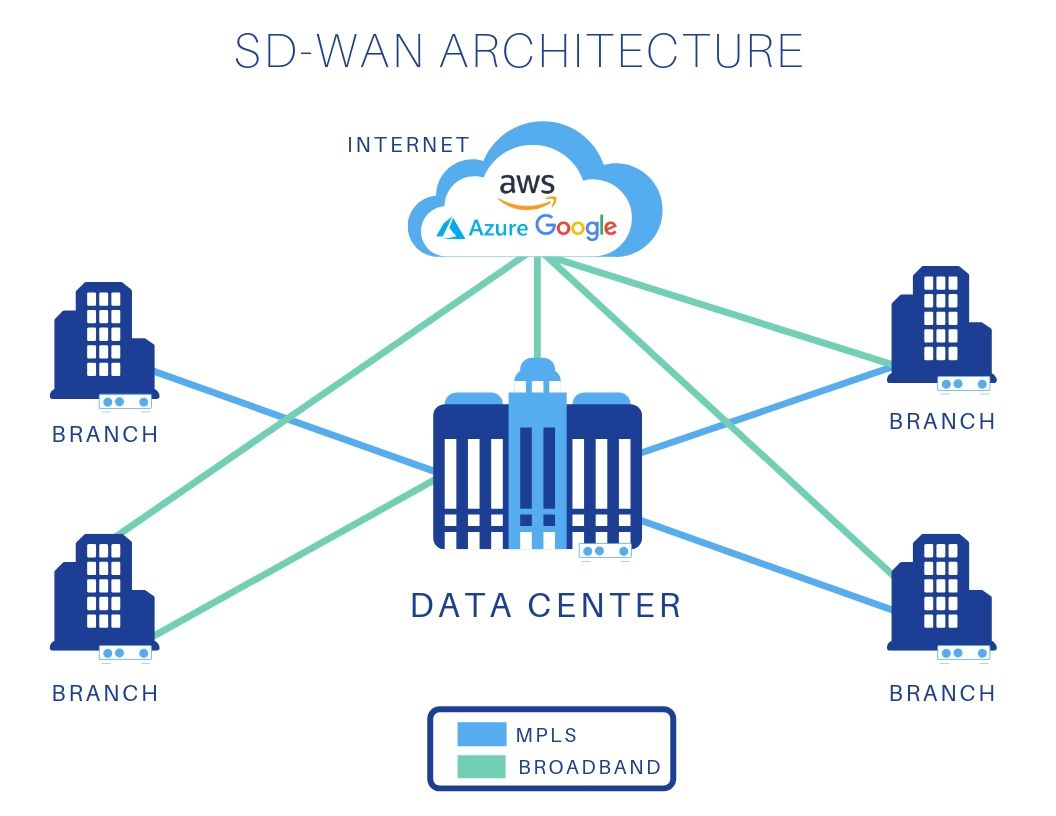
When implementing cloud networking and SD-WAN solutions, several key factors should be considered to ensure a successful deployment and maximize the benefits these solutions offer. These factors include:
- Business requirements:Clearly define the business objectives and requirements that the cloud networking and SD-WAN solutions aim to address. This includes understanding the applications and workloads that will be supported, the desired performance levels, and the security and compliance requirements.
- Network infrastructure:Assess the existing network infrastructure and identify any limitations or constraints that may impact the implementation of cloud networking and SD-WAN solutions. This includes evaluating the bandwidth capacity, latency, and reliability of the network.
- Cloud provider selection:Choose a cloud provider that offers the required services, such as Infrastructure-as-a-Service (IaaS), Platform-as-a-Service (PaaS), and Software-as-a-Service (SaaS), and that meets the performance, security, and compliance requirements of the organization.
- SD-WAN vendor selection:Select an SD-WAN vendor that provides a solution that meets the specific requirements of the organization, including features such as application-aware routing, WAN optimization, and security capabilities.
- Integration with existing systems:Consider how the cloud networking and SD-WAN solutions will integrate with existing systems, such as firewalls, intrusion detection systems, and network management tools, to ensure seamless operation and maintain a consistent security posture.
– Provide examples of real-world use cases for cloud networking and SD-WAN solutions.
Cloud networking and SD-WAN solutions offer numerous benefits for businesses of all sizes. Here are a few real-world use cases that demonstrate the power of these solutions:
Branch Office Connectivity
Cloud networking and SD-WAN can be used to connect branch offices to the corporate network in a secure and cost-effective manner. This can be especially beneficial for businesses with multiple branch offices located in different parts of the country or the world.
Cloud Application Access
Cloud networking and SD-WAN can be used to provide secure and reliable access to cloud applications, such as Salesforce, Office 365, and Google Apps. This can help businesses improve employee productivity and collaboration.
Disaster Recovery
Cloud networking and SD-WAN can be used to create a disaster recovery plan that will keep businesses up and running in the event of a natural disaster or other emergency.
Use Cases for Cloud Networking and SD-WAN Solutions
Cloud networking and SD-WAN solutions offer a wide range of use cases, addressing the connectivity and performance challenges of modern businesses.
Remote Access and Connectivity
These solutions provide secure and reliable remote access to corporate resources, enabling employees to work from anywhere. By leveraging the cloud, businesses can extend their networks to remote locations without the need for complex and expensive hardware.
Cloud Application Integration
Cloud networking and SD-WAN solutions seamlessly integrate cloud applications into existing networks, optimizing performance and enhancing user experience. They provide secure and reliable access to SaaS applications, such as CRM, ERP, and collaboration tools.
Network Optimization and Performance Improvement
By leveraging SD-WAN technology, businesses can optimize network performance and reduce latency. SD-WAN solutions dynamically route traffic across multiple connections, ensuring optimal performance for critical applications and improving overall network efficiency.
Security and Compliance
Cloud networking and SD-WAN solutions provide enhanced security features, protecting businesses from cyber threats and ensuring compliance with regulatory requirements. They offer features such as encryption, intrusion detection, and firewall protection, safeguarding data and preventing unauthorized access.
Trends and Future of Cloud Networking and SD-WAN Solutions
Cloud networking and SD-WAN technologies are constantly evolving, driven by advancements in cloud computing, network virtualization, and software-defined networking (SDN). These trends are shaping the future of networking, offering businesses new opportunities to improve performance, agility, and security.
Emerging Trends in Cloud Networking and SD-WAN Technologies
Some of the key emerging trends in cloud networking and SD-WAN technologies include:
- Increased adoption of cloud-based networking services:Businesses are increasingly moving their networking infrastructure to the cloud, taking advantage of the scalability, flexibility, and cost-effectiveness of cloud-based solutions.
- Greater use of software-defined networking (SDN):SDN is a technology that decouples the network control plane from the data plane, providing greater flexibility and programmability in network management.
- Adoption of network functions virtualization (NFV):NFV allows network functions to be virtualized and run on standard hardware, making it easier to deploy and manage new network services.
- Increased use of artificial intelligence (AI) and machine learning (ML):AI and ML are being used to automate network management tasks, improve performance, and detect and mitigate security threats.
Potential Impact of These Trends on Businesses
These emerging trends have the potential to significantly impact businesses in a number of ways:
- Improved performance and agility:Cloud networking and SD-WAN solutions can help businesses improve network performance and agility by providing on-demand access to network resources and enabling rapid deployment of new services.
- Reduced costs:Cloud networking and SD-WAN solutions can help businesses reduce costs by eliminating the need for expensive hardware and by providing pay-as-you-go pricing models.
- Enhanced security:Cloud networking and SD-WAN solutions can help businesses enhance security by providing built-in security features and by enabling businesses to implement security policies more easily.
- Improved scalability:Cloud networking and SD-WAN solutions can help businesses scale their networks quickly and easily to meet changing business needs.
Insights into the Future of Cloud Networking and SD-WAN Solutions
As cloud networking and SD-WAN technologies continue to evolve, we can expect to see even greater adoption of these solutions by businesses. Cloud networking and SD-WAN solutions will become increasingly sophisticated, offering businesses new and innovative ways to improve network performance, agility, security, and scalability.In
the future, we can expect to see:
- Greater integration of cloud networking and SD-WAN solutions with other cloud services:This will enable businesses to create end-to-end cloud-based solutions that are tailored to their specific needs.
- Increased use of AI and ML in cloud networking and SD-WAN solutions:This will further automate network management tasks and improve network performance and security.
- Development of new cloud networking and SD-WAN solutions that are specifically designed for emerging technologies:This will help businesses to take advantage of new technologies such as IoT, 5G, and edge computing.
By embracing cloud networking and SD-WAN solutions, businesses can position themselves to take advantage of the latest networking technologies and to meet the challenges of the digital age.
Case Studies of Cloud Networking and SD-WAN Implementations
Cloud networking and SD-WAN solutions have been successfully implemented in various industries, delivering significant benefits to businesses. Here are a few notable case studies that demonstrate the challenges, lessons learned, and quantifiable results achieved through these implementations:
Retail Giant Improves Customer Experience with Cloud Networking
A leading retail chain faced challenges with network latency and unreliable connectivity, which impacted the customer shopping experience. By implementing a cloud networking solution, they were able to:
- Reduce network latency by 50%, resulting in faster page loading times and improved customer satisfaction.
- Enhance network reliability by leveraging multiple cloud providers, ensuring uninterrupted connectivity for critical applications.
- Optimize bandwidth utilization by implementing traffic shaping and load balancing, reducing network congestion and improving overall performance.
Manufacturing Company Boosts Productivity with SD-WAN
A global manufacturing company struggled with complex network configurations and high maintenance costs. By deploying an SD-WAN solution, they achieved:
- Simplified network management through centralized control and automation, reducing IT workload and improving efficiency.
- Increased network flexibility by enabling rapid deployment of new sites and applications, supporting business growth.
- Reduced operating costs by consolidating multiple network providers and optimizing bandwidth utilization.
Healthcare Provider Enhances Patient Care with Cloud Networking and SD-WAN
A healthcare provider sought to improve network connectivity and security for its distributed clinics and remote workers. By integrating cloud networking and SD-WAN, they:
- Ensured reliable and secure access to patient records and medical applications, enhancing patient care.
- Reduced network downtime by leveraging cloud-based disaster recovery capabilities, minimizing disruptions to critical services.
- Optimized network performance for real-time applications, such as video conferencing and telemedicine, improving collaboration and patient outcomes.
Security Considerations for Cloud Networking and SD-WAN Solutions
Cloud networking and SD-WAN solutions offer numerous advantages, but they also introduce unique security challenges that differ from traditional networking models. Understanding these challenges and implementing robust security measures is crucial for ensuring the security of cloud networking and SD-WAN deployments.
Potential Security Risks and Vulnerabilities
Cloud networking and SD-WAN solutions face various security risks and vulnerabilities, including:
- Increased attack surface:Cloud networking and SD-WAN expand the network perimeter, creating a larger attack surface for potential threats.
- Data breaches:Sensitive data stored in the cloud or transmitted over SD-WAN links can be vulnerable to data breaches.
- Malware and ransomware attacks:Cloud networking and SD-WAN environments can be targeted by malware and ransomware attacks that can disrupt operations or steal sensitive information.
- DDoS attacks:Distributed denial-of-service (DDoS) attacks can overwhelm cloud networking and SD-WAN infrastructure, causing service outages.
– Explain the management and monitoring requirements for cloud networking and SD-WAN solutions, including
Effective management and monitoring are critical for ensuring the optimal performance and security of cloud networking and SD-WAN solutions. These solutions introduce a new level of complexity to network management, making it essential to have the right tools and strategies in place.
– Network visibility and monitoring
Network visibility is essential for understanding how your network is performing and identifying any potential issues. Cloud networking and SD-WAN solutions can make it difficult to achieve network visibility, as traffic can be distributed across multiple clouds and networks. To address this, it is important to use tools that provide end-to-end visibility into your network, including both cloud and on-premises components.
– Performance monitoring and analysis
Performance monitoring is essential for ensuring that your network is meeting the needs of your business. Cloud networking and SD-WAN solutions can introduce new performance challenges, such as latency and jitter. To address this, it is important to use tools that can monitor network performance in real time and identify any potential bottlenecks.
– Security monitoring and threat detection
Security monitoring is essential for protecting your network from threats. Cloud networking and SD-WAN solutions can introduce new security risks, such as increased exposure to the public internet. To address this, it is important to use tools that can monitor your network for security threats and detect any suspicious activity.
– Capacity planning and forecasting
Capacity planning is essential for ensuring that your network has the capacity to meet the needs of your business. Cloud networking and SD-WAN solutions can make it difficult to accurately forecast capacity needs, as traffic patterns can be unpredictable. To address this, it is important to use tools that can help you forecast capacity needs and identify any potential capacity shortfalls.
– Cost optimization and budgeting
Cost optimization is essential for controlling the costs of your cloud networking and SD-WAN solution. These solutions can be expensive, so it is important to have a clear understanding of your costs and identify any opportunities for savings. To address this, it is important to use tools that can help you track your costs and identify any areas where you can save money.
Integration of Cloud Networking and SD-WAN Solutions with Other Technologies
Cloud networking and SD-WAN solutions seamlessly integrate with other technologies, enhancing their capabilities and unlocking new possibilities.
Cloud Computing
Integrating cloud networking and SD-WAN with cloud computing empowers businesses with scalable, agile, and cost-effective IT infrastructures. SD-WAN optimizes network connectivity to cloud platforms, ensuring reliable and secure access to cloud applications and services. This integration enables seamless cloud adoption, reducing latency and improving application performance.
Network Security
Combining cloud networking and SD-WAN with network security solutions provides comprehensive protection against cyber threats. SD-WAN’s ability to segment traffic and prioritize critical applications allows for granular security policies. Integrating with firewalls, intrusion detection systems, and other security tools enhances threat detection and response capabilities, safeguarding network and data integrity.
Application Performance Management
Integrating cloud networking and SD-WAN with application performance management (APM) tools empowers IT teams with real-time visibility into application performance across the network. APM tools monitor application metrics, such as response time, availability, and user experience, enabling proactive identification and resolution of performance issues.
This integration optimizes application delivery and ensures a seamless user experience.
Benefits of Integration, Cloud networking and SD-WAN solutions
- Enhanced performance and reliability
- Improved security and compliance
- Cost optimization and scalability
- Simplified management and automation
Challenges of Integration
- Complexity of managing multiple technologies
- Ensuring compatibility and interoperability
- Securing data and applications across different environments
Successful Integrations
Numerous organizations have successfully integrated cloud networking and SD-WAN solutions with other technologies. For instance, a global healthcare provider implemented a cloud-based EHR system and integrated it with an SD-WAN network. This integration improved patient data access, reduced network latency, and enhanced the overall user experience.
Lessons Learned
- Plan thoroughly and assess compatibility
- Prioritize security and data protection
- Implement automation and monitoring tools
- Collaborate with vendors and partners
Cost Considerations for Cloud Networking and SD-WAN Solutions
Cloud networking and SD-WAN solutions offer numerous benefits, but it’s essential to consider the associated costs. Understanding the pricing models and cost factors involved will help you optimize your investment and maximize the return.
Pricing Models
- Subscription-based:A recurring monthly or annual fee that covers access to the cloud networking or SD-WAN platform, including features, support, and updates.
- Pay-as-you-go:Charges are based on usage, such as data transfer or the number of virtual network instances created.
- Hybrid:A combination of subscription-based and pay-as-you-go models, offering flexibility and cost control.
Cost Factors
- Network bandwidth:The cost of bandwidth can vary depending on the provider, region, and usage patterns.
- Virtual network instances:The number of virtual network instances (VNIs) deployed will impact costs.
- Features and add-ons:Additional features, such as security enhancements or advanced routing capabilities, may come with additional costs.
- Management and support:The level of management and support required can affect costs.
Strategies for Optimizing Costs
- Choose the right pricing model:Select a pricing model that aligns with your usage patterns and cost requirements.
- Negotiate with providers:Explore volume discounts or long-term contracts to reduce costs.
- Optimize network usage:Monitor network traffic and identify opportunities to reduce bandwidth consumption.
- Utilize cloud cost management tools:Leverage tools provided by cloud providers to track and manage cloud networking and SD-WAN costs.
Vendor Landscape for Cloud Networking and SD-WAN Solutions
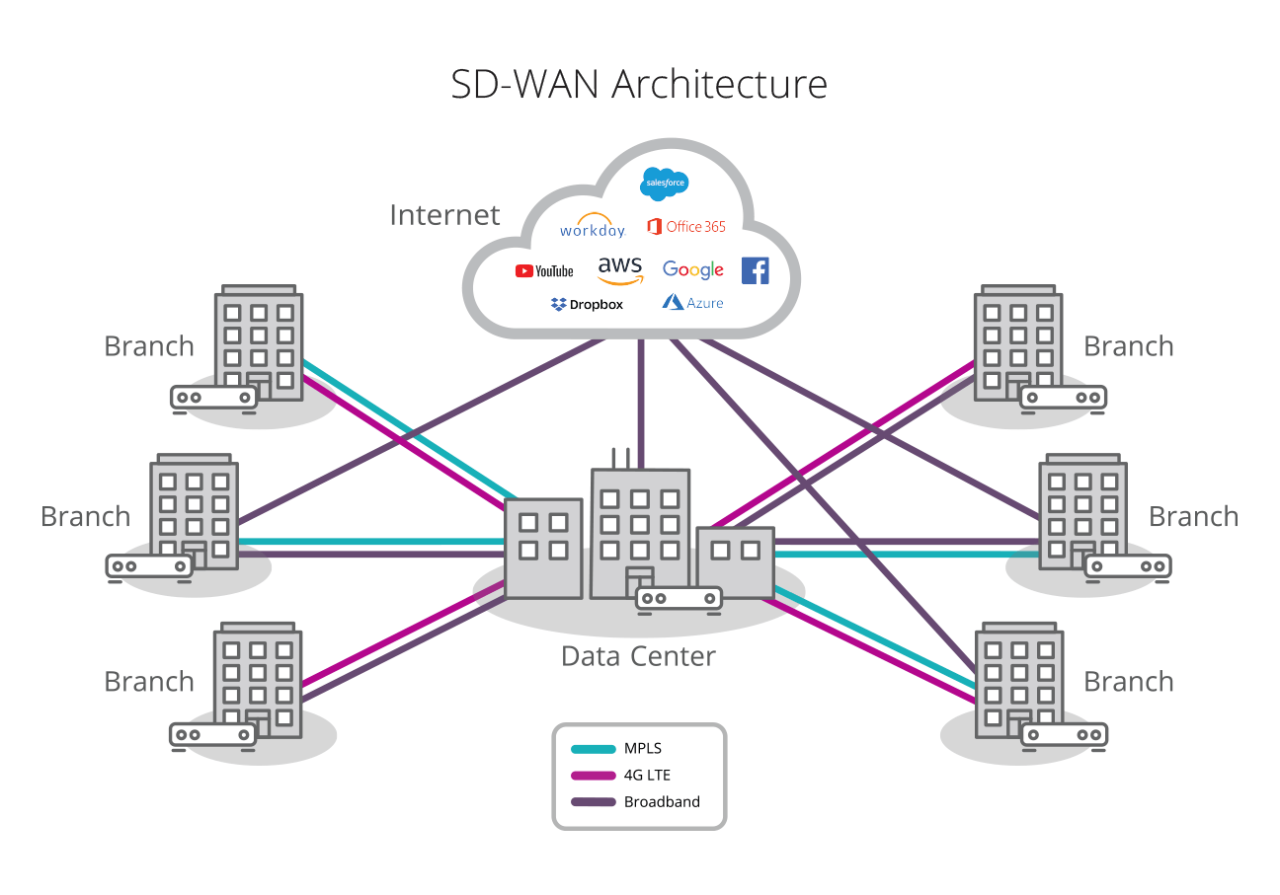
In the rapidly evolving market for cloud networking and SD-WAN solutions, numerous vendors are vying for attention. Each vendor brings its own unique strengths and weaknesses to the table, making it crucial for businesses to carefully evaluate their options before making a decision.
Key Vendors in the Market
The key vendors in the cloud networking and SD-WAN market include:
- Cisco
- VMware
- Aryaka
- Fortinet
- Palo Alto Networks
- Zscaler
- CloudGenix
Strengths and Weaknesses of Vendor Offerings
Cisco: Cisco is a leading provider of networking solutions, with a strong presence in both the enterprise and service provider markets. Cisco’s cloud networking and SD-WAN solutions are known for their reliability, security, and scalability. However, Cisco’s solutions can be more expensive than some of its competitors.VMware:
VMware is a leading provider of virtualization and cloud management software. VMware’s cloud networking and SD-WAN solutions are known for their ease of use and integration with VMware’s other products. However, VMware’s solutions may not be as feature-rich as some of its competitors.Aryaka:
Aryaka is a leading provider of cloud-based networking solutions. Aryaka’s cloud networking and SD-WAN solutions are known for their high performance and global reach. However, Aryaka’s solutions may not be as customizable as some of its competitors.Fortinet: Fortinet is a leading provider of network security solutions.
Fortinet’s cloud networking and SD-WAN solutions are known for their security features and performance. However, Fortinet’s solutions may not be as feature-rich as some of its competitors.Palo Alto Networks: Palo Alto Networks is a leading provider of network security solutions.
Palo Alto Networks’ cloud networking and SD-WAN solutions are known for their security features and ease of use. However, Palo Alto Networks’ solutions may not be as feature-rich as some of its competitors.Zscaler: Zscaler is a leading provider of cloud-based security solutions.
Zscaler’s cloud networking and SD-WAN solutions are known for their security features and global reach. However, Zscaler’s solutions may not be as customizable as some of its competitors.CloudGenix: CloudGenix is a leading provider of cloud-based networking solutions. CloudGenix’s cloud networking and SD-WAN solutions are known for their ease of use and automation features.
However, CloudGenix’s solutions may not be as feature-rich as some of its competitors.
Vendor Comparison Table
The following table provides a comparison of the key vendors in the cloud networking and SD-WAN market:| Vendor | Strengths | Weaknesses ||—|—|—|| Cisco | Reliability, security, scalability | Expensive || VMware | Ease of use, integration with VMware products | Not as feature-rich || Aryaka | High performance, global reach | Not as customizable || Fortinet | Security features, performance | Not as feature-rich || Palo Alto Networks | Security features, ease of use | Not as feature-rich || Zscaler | Security features, global reach | Not as customizable || CloudGenix | Ease of use, automation features | Not as feature-rich |
Emerging Technologies and Innovations in Cloud Networking and SD-WAN Solutions
Cloud networking and SD-WAN solutions are constantly evolving, with new technologies and innovations emerging all the time. These technologies are shaping the future of cloud networking and SD-WAN, making them more powerful, efficient, and secure.
Some of the most important emerging technologies in cloud networking and SD-WAN include:
- Software-defined networking (SDN): SDN is a technology that allows network administrators to programmatically control the network. This makes it easier to manage and configure the network, and it can also improve performance and security.
- Network function virtualization (NFV): NFV is a technology that allows network functions to be virtualized and run on standard hardware. This makes it easier to deploy and manage network functions, and it can also reduce costs.
- Cloud-native networking: Cloud-native networking is a set of technologies that are designed to be deployed and managed in the cloud. These technologies are often more scalable, flexible, and cost-effective than traditional networking technologies.
- Artificial intelligence (AI): AI is being used to automate many tasks in cloud networking and SD-WAN. This can improve efficiency and accuracy, and it can also help to identify and resolve problems before they become major issues.
These are just a few of the emerging technologies that are shaping the future of cloud networking and SD-WAN. As these technologies continue to develop, we can expect to see even more innovation and progress in this area.
Best Practices for Implementing Cloud Networking and SD-WAN Solutions
Implementing cloud networking and SD-WAN solutions can significantly enhance network performance, agility, and security. However, it’s crucial to follow best practices to ensure a successful implementation and maximize the benefits. Here are some key practices to consider:
Design a Comprehensive Network Architecture
Before implementing cloud networking and SD-WAN, it’s essential to design a comprehensive network architecture that aligns with your organization’s specific requirements. Consider the cloud services you plan to use, the number of users and devices, and the bandwidth and latency requirements.
A well-designed architecture will provide a solid foundation for your network and ensure optimal performance.
Implement a Hybrid Network
A hybrid network approach combines traditional WAN with SD-WAN to optimize performance and cost. By leveraging SD-WAN for internet-based applications and traditional WAN for mission-critical applications, you can achieve the best of both worlds. This approach provides flexibility, scalability, and cost savings.
Use a Cloud-Based Network Management Platform
A cloud-based network management platform provides centralized visibility and control of your entire network. It allows you to manage cloud and on-premises resources from a single pane of glass, simplifying network operations and troubleshooting. Choose a platform that offers comprehensive monitoring, analytics, and automation capabilities.
Secure Your Network
Security is paramount when implementing cloud networking and SD-WAN solutions. Implement strong security measures such as firewalls, intrusion detection systems, and encryption to protect your data and applications. Regularly update software and firmware to address security vulnerabilities and ensure compliance with industry standards.
Monitor Your Network
Continuous monitoring is essential to maintain optimal network performance and identify potential issues proactively. Use network monitoring tools to track key metrics such as bandwidth utilization, latency, and packet loss. Set up alerts to notify you of any anomalies or performance degradation, allowing you to take prompt action and prevent downtime.
– Optimize Network Architecture
To optimize your network architecture for cloud networking and SD-WAN solutions, it is crucial to review your network topology and identify any potential bottlenecks that may hinder performance. Implement a hierarchical network design with multiple tiers and redundancy to ensure reliability and flexibility.
Utilize traffic shaping and load balancing techniques to distribute traffic evenly across available network paths, maximizing resource utilization and minimizing latency.
Implement Hierarchical Network Design
- Tiered architecture allows for logical separation of network functions, improving scalability and security.
- Redundancy ensures that critical network components have backups in case of failures, enhancing reliability.
Ending Remarks
Cloud networking and SD-WAN solutions are not just a technological upgrade but a strategic investment in the future of your business. By embracing these solutions, you can gain a competitive edge, optimize your operations, and unlock new possibilities for growth and innovation.


